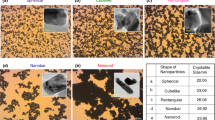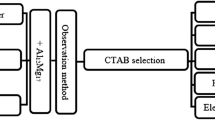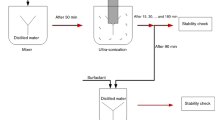Abstract
The main aim of this work is to investigate the influence of different parameters on the stability of spherical CuO nanoparticles dispersed in water, ethylene glycol and 50:50 water/ethylene glycol binary mixture as different base fluids for heat transfer applications. Nano-fluids were prepared using two-step method at weight concentration of 0.1–0.4 %. Time-settlement experiments were established to examine the stability of nano-fluids. Quality tests were also performed to investigate the morphology, purity and size of nanoparticles. In order to stabilize the nano-fluids, stirring, pH control and sonication were utilized. The criteria for assessing the stability of nano-fluids were zeta potential and time-settlement experiments. Results demonstrated that the ethylene glycol can be the best medium for dispersing the CuO nanoparticle in comparison with water and water/EG binary mixture. The best condition for achieving the most stable nano-fluid was also introduced. Role of sonication time, stirring time and addition of surfactant on the stability of nano-fluids were investigated and briefly discussed.







Similar content being viewed by others
References
Choi SUS (1995) Enhancing thermal conductivity of fluids with nanoparticles. In: Developments and applications of non-newtonian flows, ASME FED 231/MD66, pp 99–103
Lee S, Choi SUS, Li S, Eastman JA (1999) Measuring thermal conductivity of fluids containing oxide nanoparticles. J Heat Transf Trans ASME 121:280–289
Wang X, Xu X, Choi SUS (1999) Thermal conductivity of nanoparticle–fluid mixture. J Thermo Phys Heat Transf 13:474–480
Zafarani-Moattar MT, Majdan-Cegincara R (2013) Investigation on stability and rheological properties of nano-fluid of ZnO nanoparticles dispersed in poly (ethylene glycol). Fluid Phase Equilib 354:102–108
Sarafraz MM, Hormozi F (2014) Scale formation and subcooled flow boiling heat transfer of CuO–water nano-fluid inside the vertical annulus. Exp Thermal Fluid Sci 52:205–214
Saidur R, Leong KY, Mohammad HA (2011) A review on applications and challenges of nano-fluids. Renew Sustain Energy Rev 15:1646–1668
Peyghambarzadeh SM, Hashemabadi SH, Naraki M, Vermahmoudi Y (2013) Experimental study of overall heat transfer coefficient in the application of dilute nano-fluids in the car radiator. Appl Therm Eng 52:8–16
Witharana S, Palabiyik I, Musina Z, Ding Y (2013) Stability of glycol nano-fluids—the theory and experiment. Powder Technol 239:72–77
Lin C, Wang JC, Chen TC (2011) Analysis of suspension and heat transfer characteristics of Al2O3 nano-fluids prepared through ultrasonic vibration. Appl Energy 88:4527–4533
Das SK, Putra N, Thiesen P, Roetzel W (2003) Temperature dependence of thermal conductivity enhancement for nano-fluids. J Heat Transf 125:8
Asirvatham LG, Vishal N, Gangatharan SK, Lal DM (2009) Experimental study on forced convective heat transfer with low volume fraction of CuO/water nano-fluid. Energies 2(1):97–119
Hwang Y, Lee JK, Lee CH, Jung YM, Cheong SI, Lee CG, Ku BC, Jang SP (2007) Stability and thermal conductivity characteristics of nano-fluids. Thermochim Acta 455(1–2):70–74
Lee D, Kim J-W, Kim BG (2006) A new parameter to control heat transport in nano-fluids: surface charge state of the particle in suspension. J Phys Chem 110:4323–4328
Li XF, Zhu DS, Wang XJ, Wang N, Gao JW, Li H (2008) Thermal conductivity enhancement dependent pH and chemical surfactant for Cu–H2O nano-fluids. Thermochim Acta 469(1–2):98–103
Hwang YJ, Ahn YC, Shin HS, Lee CG, Kim GT, Park HS, Lee JK (2006) Investigation on characteristics of thermal conductivity enhancement of nano-fluids. Curr Appl Phys 6(6):1068–1071
Sarafraz MM, Hormozi F (2014) Convective boiling and particulate fouling of stabilized CuO–ethylene glycol nano-fluids inside the annular heat exchanger. Int Commun Heat Mass Transf. doi:10.1016/j.icheatmasstransfer.2014.02.019
Wen DS, Ding YL (2005) Formulation of nano-fluids for natural convective heat transfer applications. Int J Heat Fluid Flow 26:855–864
Zhu D, Li X, Wang N, Wang X, Gao J, Li H (2009) Dispersion behavior and thermal conductivity characteristics of Al2O3–H2O nano-fluids. Curr Appl Phys 9:131–139
Li X, Zhu D, Wang X (2007) Evaluation on dispersion behavior of the aqueous copper nano-suspensions. J Colloids Interface Sci 310:456–463
Wang JX, Zhu HT, Zhang CY, Tang YM, Ren B, Yin YS (2007) Preparation and thermal conductivity of suspensions of graphite nanoparticles. Carbon 45:226
Pak BC, Cho Y (1998) Hydrodynamic and heat transfer studies of dispersed fluids with sub-micronmetallic oxide particles. Exp Heat Transf 11:151–170
Witharana S, Hodges C, Xu D, Lai X, Ding Y (2012) Aggregation and settling in aqueous polydisperse alumina nanoparticle suspensions. J Nanopart Res 14:851
Palabiyik I, Musina Z, Witharana S, Ding Y (2011) Dispersion stability and thermal conductivity of propylene glycol-based nano-fluids. J Nanopart Res 13:5049–5055
Sarafraz MM, Hormozi F (2014) Convective boiling and particulate fouling of stabilized CuO–ethylene glycol nanofluids inside the annular heat exchanger. Int Commun Heat Mass Transf 53:116–123
Sarafraz MM, Pyghambarzadeh SM (2012) Nucleate pool boiling heat transfer to Al2O3–water and TiO2–water nano-fluids on horizontal smooth tubes with dissimilar homogeneous materials. Chem Biochem Eng Q 26(3):199–206
Sarafraz MM, Peyghambarzadeh SM (2013) Experimental study on sub-cooled flow boiling heat transfer to water–diethylene glycol mixtures as a coolant inside a vertical annulus. Exp Therm Fluid Sci 50:154–162
Sarafraz MM, Hormozi F (2014) Scale formation and sub-cooled flow boiling heat transfer of CuO–water nano-fluid inside the vertical annulus. Exp Therm Fluid Sci 52:205–214
Sarafraz MM, Hormozi F (2015) Pool boiling heat transfer to dilute copper oxide aqueous nanofluids. Int J Therm Sci 90:224–237
Farrokhpay S (2009) A review of polymeric dispersant stabilization of titania pigment. Adv Colloid Interface Sci 151:24–32
Chang H, Jwo C, Fan P, Pai S (2007) Process optimization and material properties for nano-fluid manufacturing. Int J Adv Manuf Technol 34(3):300–306
Ghadimi A, Saidur R, Metselaar HSC (2011) A review of nano-fluid stability properties and characterization in stationary conditions. Int J Heat Mass Transf 54:4051–4068
Wu TY, Guo N, Teh CY, Hay JXW (2013) Advances in ultrasound technology for environmental remediation, chapter 2. In: Hay JXW (ed) Theory and fundamentals of ultrasound. Springer, Germany
Acknowledgments
Authors of this work tend to dedicate this article to Imam Mahdi and appreciate Semnan University for their financial supports. Also special appreciation is dedicated to MERC (Material and Energy Research Center for sharing their scientific equipment).
Author information
Authors and Affiliations
Corresponding author
Rights and permissions
About this article
Cite this article
Kamalgharibi, M., Hormozi, F., Zamzamian, S.A.H. et al. Experimental studies on the stability of CuO nanoparticles dispersed in different base fluids: influence of stirring, sonication and surface active agents. Heat Mass Transfer 52, 55–62 (2016). https://doi.org/10.1007/s00231-015-1618-z
Received:
Accepted:
Published:
Issue Date:
DOI: https://doi.org/10.1007/s00231-015-1618-z




